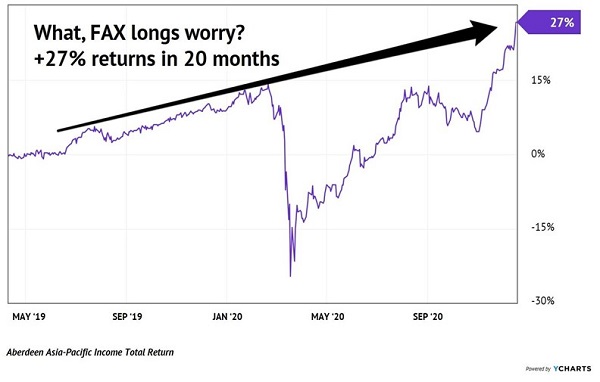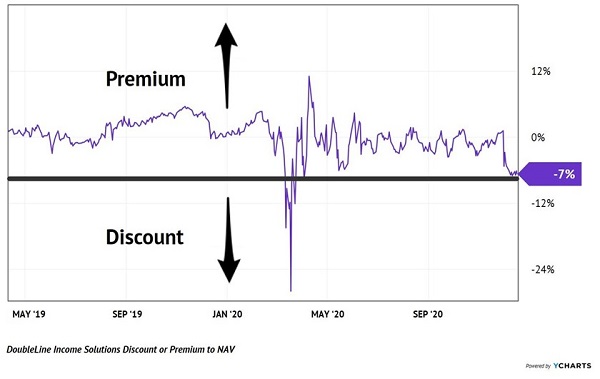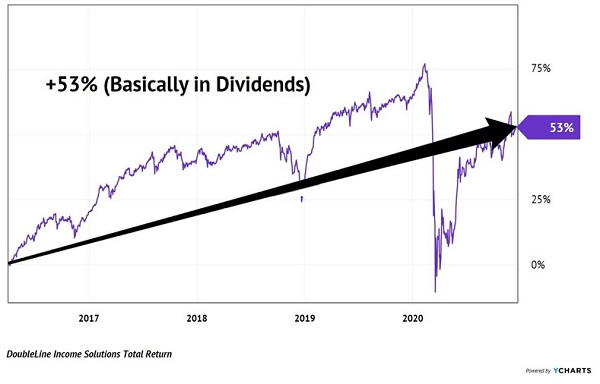When this closed-end fund (CEF) lowered its monthly dividend for the first time in 17 years, many income investors (understandably) panicked and sold.
Too bad for them. They missed out on 27% returns over the next 20 months.
Can a dividend cut actually be a good thing? Like life itself, it’s complicated—but my short answer is “yes.” Here’s when (and why).
CEFs are the exception to the “dividend cuts are bad” rule. In CEF-Land, payouts are taken from a fund’s portfolio, which is represented by a fund’s net asset value (NAV).
Sure, the funds that we buy generally have income streams that are supposed to “power” NAV higher.
But the flow of funds is such that the fund gets paid, and then we investors get paid.
As far as we are concerned, there are two main ways for a CEF to fund its dividend:
- Through income generated by its holdings (its own high-yield bonds, for example), and/or
- Gains in NAV (an appreciation of the value of those holdings.)
We can think of the NAV and the dividends as being on a seesaw together. The higher the yield, the more pressure on NAV—and vice versa.
Since we are in it for the income, we look for CEFs that pay generous dividends. And, in return, all we ask for is a stable NAV or better, which shows us that the fund is not overpaying us when it dishes our dividend every month (or quarter).
So, when the Aberdeen Asia-Pacific Income Fund (FAX) lowered its monthly payout for the first time in nearly two decades in April 2019, I argued it was actually no big deal, for two reasons.
First, the fund still paid 8% at the time. Not bad in this zero-point-nothing world.
Second, the dividend change was really just an accounting footnote. Sure, it meant a little less cash every month. But the savings would accrue to the fund’s NAV, which in turn would lift its price. And that’s exactly what’s happened.
Now don’t get me wrong, the fund was initially sold by investors who didn’t make this connection. Two weeks after the announcement, FAX was 4% lower—a big move for a normally stable bond fund. This was actually a great buying opportunity, as the fund would deliver 27% total returns in the 20 months to follow:
Just the FAX: Total Returns Unaffected

Had FAX not cut its dividend, its total returns during that 20-month time period would have been… 27%. The same.
The difference in the dividend policy means we collected a bit less in cash and a bit more in price appreciation. All things being equal, we of course prefer the money. But gains are gains and as I mentioned earlier, 8% is still generous enough for our current income needs.
And oh by the way, when we consider FAX today, we see that we still have a nice buying opportunity, thanks to the fund’s
- 7.6% yield,
- 12% discount to NAV, and
- The likelihood that its NAV will increase as demand for its high-paying bonds increases.
We now have a similar buying opportunity in the DoubleLine Income Solutions Fund (DSL). The CEF, managed by the “bond god” Jeffrey Gundlach and his team, caused quite the stir when it announced its own payout reduction to kick off this month.
DSL has recently traded at a premium to its NAV, but the “dividend disgrace” has landed the fund back in the bargain bin:
DSL Back to a Discount

Since we added the fund to our Contrarian Income Report portfolio that year, it’s rewarded us with 53% total returns. Most of that has come in the form of the fund’s monthly dividend. (The fund’s NAV sits today roughly where it was when we originally bought DSL. Which is great. That’s all we ask of a high-paying CEF—just keep the NAV steady!)
DSL’s 53% Total Returns for CIR

After the dividend change, the fund still pays a great 8% and now trades at a nice 6% discount to its NAV. Sound familiar? This is analogous to the setup we saw in FAX after its own payout spectacle.
Fittingly, DSL’s NAV is doing about as much of a “moonshot” as we ever see in CEF-Land. It’s up 14% over the past six months, with 4% of these gains coming after the payout heartbreak event. The fund’s price, meanwhile, still sits below its previous celebrated levels, as scared income seekers have dumped DSL without considering its likely comeback.
If you haven’t yet bought this dip, this is a nice time to initiate a position in DSL or add to an existing one. I suspect that when we look back on this opportunity months from now—when another high-quality CEF lowers its dividend—we’ll be wishing we bought more of the bond god during DSL’s brief moment in the bargain bin.
— Brett Owens
Urgent Note From the Publisher [sponsor]
Kevin Wallen here—I’m the publisher here at Contrarian Outlook.
I’m breaking in here to tell you that Michael has identified 5 other CEFs that are even better buys than DIAX for the year ahead.
Like DIAX, these 5 funds have been totally overlooked in the herd’s rush into stocks. But there’s a critical difference here—TWO differences, actually:
- These 5 urgent buys sport even bigger discounts than DIAX, and …
- They pay bigger dividends, too!
These 5 funds yield an outsized 8%, on average—and that’s just the average! One of these stout income plays sends out an incredible 9.1% dividend and pays you monthly, too. Drop, say, $100K into this fund and $9,100 in dividend cash comes back to you every year.
Imagine what a huge yield like that could do for your retirement plans.
Due to these 5 funds’ massive discounts, we’ve got them pegged for gains of at least 20% in 2021. And if we do see another crash, these big discounts will help cushion these funds’ prices.
Either way, we’ll still collect their massive 8% dividends!
Small Funds, Big Upside
These 5 funds are all current recommendations of Michael’s CEF Insider service, where he focuses on CEFs with market caps under $1 billion—the sweet spot where the biggest gains, and dividends, in CEFs live.
The best way for you to discover the profit-making power of smaller CEFs is to check them out for yourself. That’s why I’ve arranged a no-risk 60-day trial to CEF Insider for you. It comes your way along with the names and tickers of these 5 “win either way” CEFs.
I’m ready to share everything with you now. Go here to get full details on these 5 high-yield funds and start your no-risk trial to CEF Insider today.
One quick final note: you do need to act quickly here. Because these are smaller funds, we need to keep our CEF Insider membership small and nimble. Don’t miss out. Get the full story now.
Source: Contrarian Outlook


